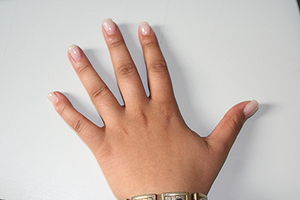
Identifying hand shape and their associated career archetypes is the most difficult part of analysing a person’s hands.
Why?
Usually specific palm markers and what they mean are clear.
It’s either a gift marker or it isn’t.
It’s either a bubble or a box or it isn’t…
Each marker has a very definite precise meaning.
Type recognition using hand shape is more difficult.
Why?
Because very few people are just one type.
Each person is a complex paradox. The dynamics of these contradictions are visible.
Looking through thousands of hand prints one
soon realises that 100% pure types are few and
far between.
Interestingly, hand shape changes as humans
change. So what palmists were looking at
and classifying and writing about
over a hundred years ago aren’t
the same types that you see today!
Normally, students only learn about advanced
hand shape types in their second year of training but I think its important
to start training your eye from the very beginning.
Just don’t beat yourself up when you can’t identify a hand
shape each and every time. It’s not easy and it takes practice.
Sometimes it helps to ask: what elements
are missing? Rather than what elements are
present.
Here are the basic rules of how to recognise the
different elements.
Earth type= a square shaped palm with short fingers
and few lines.
Fire type = uneven shaped palm (like a flame)
short fingers
lots of crackly deep Zorro like lines.
Air type= rectangular /shoebox shape hand
Long fingers, lots of carefully drawn lines
Water type= narrow palms and long fingers.
Lots of fine lines.
There are several common combinations of these
4 basic types:
For example, Earth plus Air = “the loyal soldier”
The hand is a very broad Earthy hand but has more lines on it.
Or – the fingers are longer.
Or – the hand is an air hand shape with very few lines.
Common hand shape combinations:
The Loyal soldier (Earth plus air) – likes repetitive work
The Illuminator (fire plus air) – holds up the lamp for others
The Worker bee (Earth plus Fire) – work is important
Morning mist (Water plus Air) – analytical about emotions/writer
The Drama Queen/steam (Water plus Fire) – actress
Lady of the lake/mud (Water plus Earth) – nurse/super nurturer
Other hand shapes from old systems that are still found occasionally:
The conic hand (egg shaped) – harmony is a top priority
The philosopher – air with longer knobly fingers.
Advanced hand shape types
Superimposed on this, we then take relative finger length into consideration /the mythological archetypes.
Such as?
If this is an Earth/Air hand – which finger is dominant?
Is it the Index finger ?
Or is it the middle, or ring or pinkie finger?
Each finger dominance indicates the dominance of a different
mythological archetype:
Jupiter/Zeus archetype, Saturn/Cronus, Apollo, Mercury/Hermes
Start training your eye to notice this.
Look for the elements and then look for which finger is dominant.
Earth plus a long index (Jupiter finger) is a rather different type to
Earth plus a long pinkie!
Earth hand plus long or high set Jupiter is what Unger calls the “Master of my domain” type.
Earth hand with a long Apollo finger is called “The carpenter”
A long pinkie finger (Mercurial/quick, sharp, clever) on an Earth hand
is called the “Sandbagger” or Colombo (as is movie character who
doesn’t let on how intelligent he is so everyone underestimates him. )
Keep training your eye to look for which is the dominant finger
as well as asking yourself: what elements make up this hand shape?
Or in a complex hand, what elements are missing?
Start with the basic shapes class and then, once you’re clear on this,
look for common hand shape combinations:
Loyal soldier (Earth plus air)
Illuminator (fire plus air)
Worker bee (Earth plus Fire)
Morning mist (Water plus Air)
Drama Queen/steam (Water plus Fire)
Lady of the lake/mud (Water plus Earth)
Then superimpose relative finger length on this and you have
Richard Unger’s entire system of career archetypes.
Don’t let this overwhelm you. Start with the basic building blocks.
Where are they present? Where are they missing?
Where is the paradox? Every hand has one.
On really complex hands it helps to ask: “What elements
are missing?” Rather than “What elements are present?”
To see examples of these combinations see the 2 classes on hand shape

